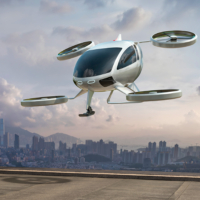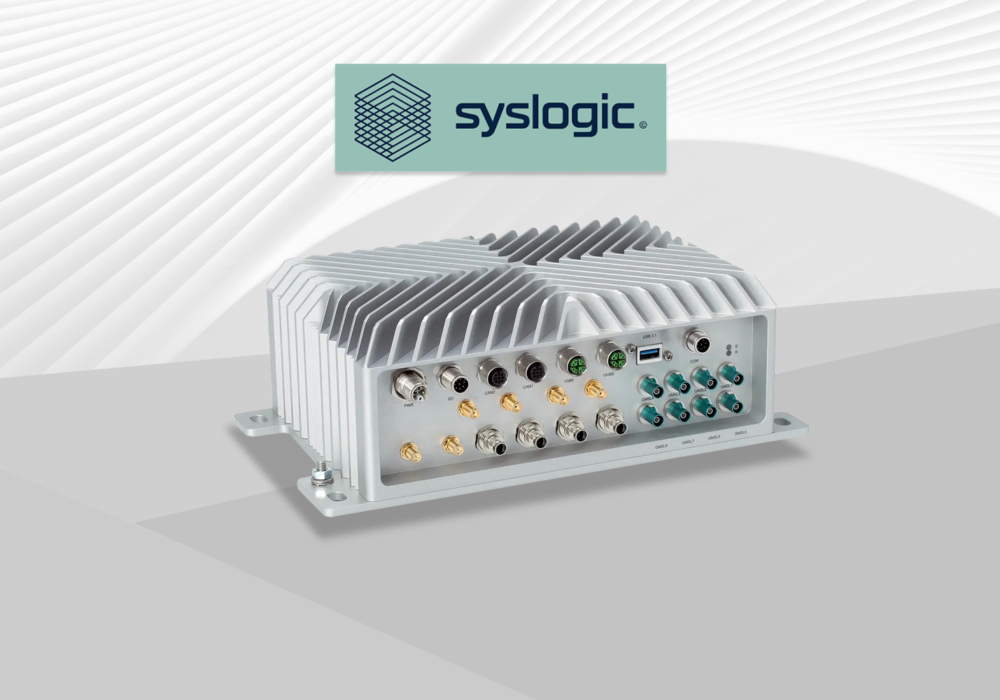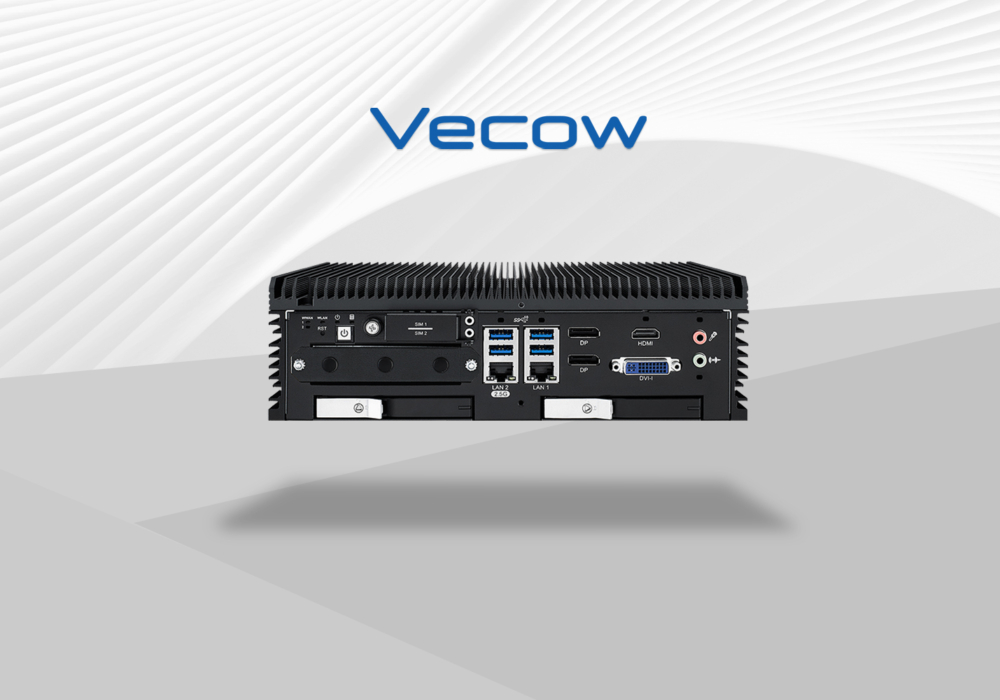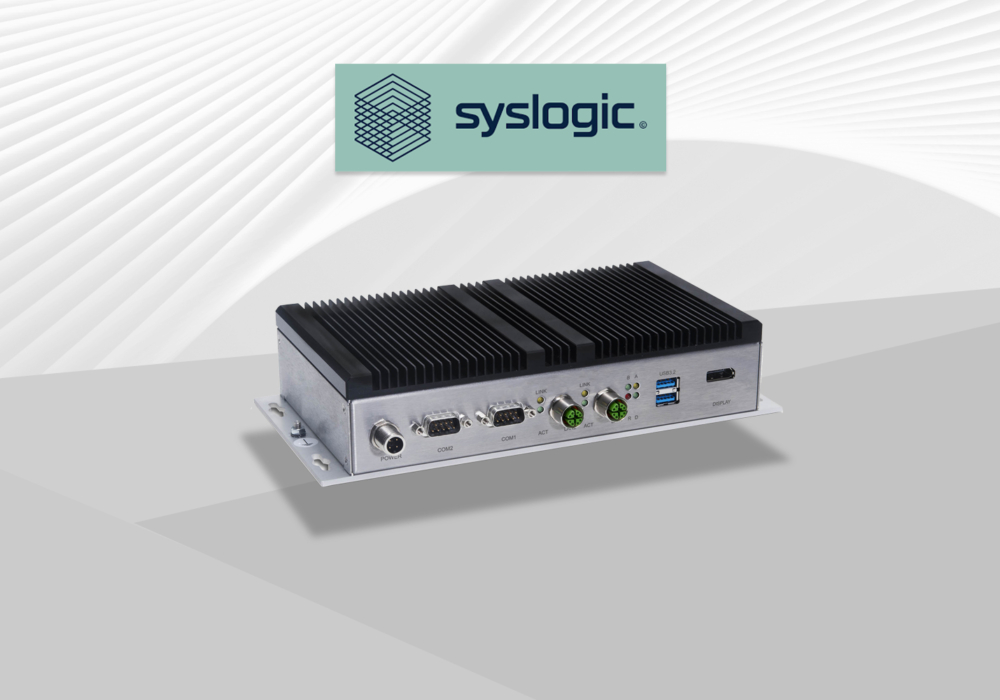In this article:
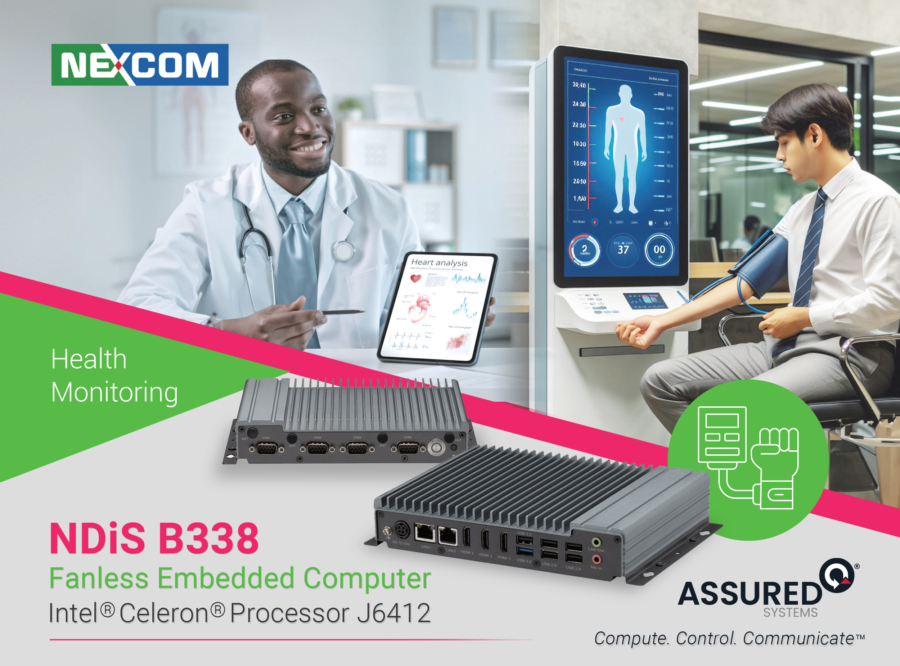
The Client
In today’s fast-paced world, the need for accessible and efficient healthcare solutions has never been more critical. The client sought a embedded computing solution for a self-service health check kiosk to address these growing demands, particularly in the diverse settings of their region, ranging from bustling urban areas to remote rural locations. The goal was to enhance healthcare delivery, offering numerous advantages over traditional visits to medical facilities or general practitioners (GPs).
Accessibility and Convenience
Self-service health check kiosks provide unparalleled accessibility and convenience. In urban areas, where time is often at a premium, these kiosks can be strategically placed in high-traffic locations such as shopping centres, corporate offices, and public transport hubs. This allows individuals to quickly check vital health parameters, such as blood pressure, heart rate, and body mass index (BMI), without the need for a scheduled appointment. The convenience of these kiosks means that individuals can integrate health monitoring into their daily routines, fostering a proactive approach to health management.
Bridging the Gap in Remote Areas
In rural and remote locations, access to healthcare services can be limited due to distance and the scarcity of medical facilities. The cleints aim was that Self-service health check kiosks would bridge this gap by providing essential health services in areas where visiting a GP or a hospital might be impractical. These kiosks can be installed in community centres, schools, or local stores, offering residents a reliable means to monitor their health. By doing so, they help in early detection of potential health issues, which is crucial for timely intervention and treatment.
Cost-Effective Healthcare
One of the significant benefits of self-service health check kiosks is their cost-effectiveness. Traditional medical visits can be expensive, considering the costs of consultations, travel, and time off work. Health kiosks, on the other hand, offer a low-cost alternative for routine health checks. This cost efficiency can be particularly beneficial for underserved populations and individuals without health insurance. Moreover, these kiosks can reduce the burden on healthcare facilities by minimising unnecessary visits for minor health issues, allowing medical professionals to focus on more critical cases.
Promoting Preventive Healthcare
Preventive healthcare is essential for reducing the prevalence of chronic diseases and improving overall public health. The idea is that these Self-service health check kiosks will play a crucial role in promoting preventive healthcare by making health monitoring easily accessible. Regular use of these kiosks can encourage individuals to keep track of their health metrics and seek medical advice when anomalies are detected. This proactive approach can lead to early diagnosis and management of conditions such as hypertension, diabetes, and cardiovascular diseases, which are often asymptomatic in their early stages.
Versatile and Enhancing Data Collection and Health Monitoring
Self-service health check kiosks are equipped with advanced technology that allows for accurate and comprehensive data collection. These kiosks can integrate with electronic health records (EHRs), enabling seamless sharing of health data with healthcare providers. This integration can enhance the quality of care by providing doctors with up-to-date information on their patients’ health status. Additionally, aggregated data from multiple kiosks can be used for public health monitoring and research, helping identify trends and inform health policies.
Empowering Individuals
Empowerment through health education and self-monitoring is another significant advantage of self-service health check kiosks. These kiosks often provide users with personalised health reports and educational content, fostering a better understanding of their health. By empowering individuals to take control of their health, these kiosks contribute to improved health outcomes and a more health-conscious society.
In summary, the deployment of self-service health check kiosks offers numerous benefits, particularly in enhancing accessibility, promoting preventive healthcare, and reducing healthcare costs. Whether in urban centres or remote rural areas, these kiosks provide a practical and efficient solution for routine health monitoring. By integrating advanced technology and providing crucial health services outside traditional medical settings, self-service health check kiosks represent a significant step forward in making healthcare more accessible and proactive for all.
The Demands of The Application
Choosing an embedded computer for a self-service health check kiosk involved addressing several critical demands to ensure the system’s reliability, efficiency, and suitability for diverse environments. The embedded computer was required to process data from various health sensors, manage user interactions, and communicate with remote servers. Key factors to be considered included fanless operation, compactness, low power consumption, robust performance, and the benefits of using a low power draw CPU.
Fanless Operation
One of the primary demands for the embedded computer in a health check kiosk was fanless operation. Fanless systems are crucial for maintaining a hygienic environment, essential for health-related applications. Fans could circulate dust and pathogens, undesirable in a public health setting. Moreover, fanless systems reduce maintenance needs since there are no moving parts that could wear out or fail. They are also quieter, enhancing the user experience in public or quiet spaces such as libraries or offices. Fanless designs rely on passive cooling, which calls for efficient thermal management and low-power components to prevent overheating.
Compactness
The embedded computer needed to be compact to fit within the constrained space of a kiosk. Kiosks are often designed to be sleek and unobtrusive, requiring all internal components, including the embedded computer, to have a small footprint. A compact design also facilitates easier installation and maintenance. The miniaturisation of computing components, such as motherboards, solid-state drives (SSDs), and low-profile memory modules, supports the development of compact embedded systems. Additionally, compact embedded computers can be more easily integrated into various kiosk designs, whether wall-mounted, free-standing, or countertop models.
Low Power Consumption
Low power consumption was another critical requirement for the embedded computer. Kiosks are often deployed in locations where energy efficiency is paramount, either due to limited power availability or to minimise operational costs. A low-power embedded computer reduces electricity usage and generates less heat, aiding in passive cooling efforts. Advances in low-power processors, such as ARM or Intel Atom and Celeron chips, enable embedded systems to perform complex tasks while consuming minimal power. This efficiency is particularly beneficial for kiosks in remote areas or those running on battery or solar power.
Benefits of a Low Wattage TDP CPU
A CPU with a low wattage Thermal Design Power (TDP) was particularly beneficial. TDP refers to the maximum amount of heat a CPU can generate that the cooling system is designed to dissipate under maximum workload. A low TDP indicates that the CPU is designed to consume less power and generate less heat. This closely relates to low power consumption, as a lower TDP typically means the CPU will draw less power during operation, which translates to lower energy costs and improved energy efficiency.
Using a CPU with a low TDP reduces the need for active cooling solutions like fans, enabling a fully passive cooling design. This not only keeps the system cooler and more stable but also prolongs the lifespan of components by reducing thermal stress. Additionally, a low TDP CPU helps in maintaining the compact and streamlined design of the kiosk, as less space is needed for cooling infrastructure.
Robust Performance
Despite the need for low power and compactness, the embedded computer still needs to deliver robust performance as it will handle multiple tasks, including data processing from health sensors, running user interface software, and communicating with remote servers. The computer needs to be capable of running a reliable operating system, such as Linux or Windows Embedded, and supporting software applications that manage health data and user interactions. A balance between power efficiency and performance is crucial, ensuring that the kiosk operates smoothly without lag or downtime.
Connectivity and I/O Capabilities
Health check kiosks require robust connectivity options to communicate with cloud services and health databases. The computer needed to support multiple connectivity options, such as Ethernet, Wi-Fi, and possibly cellular connections for remote locations. Additionally, various input/output (I/O) ports were needed to interface with the health sensors, touchscreens, printers, and other peripherals. USB, HDMI, and serial ports are commonly required to connect and manage these components effectively.
Durability and Reliability
Durability and reliability are essential, especially for kiosks deployed in public or harsh environments. The chosen computer needed to withstand temperature fluctuations, humidity, dust, and potential physical impacts. Industrial-grade components and ruggedised designs help to ensure that the system remains operational over long periods with minimal maintenance. Reliability was also critical to the client, for maintaining user trust and ensuring that health data is accurately processed and transmitted.
Scalability and Future-Proofing
Finally, scalability and future-proofing were important considerations. The embedded computer needs to be capable of handling software updates and potential hardware upgrades to adapt to evolving technologies and health monitoring requirements. Modular designs that allow easy component replacements or enhancements could extend the kiosk’s lifespan and ensure it remains relevant as new health technologies emerge.
In summary, the embedded computer for a self-service health check kiosk needs to be fanless, compact, low-power, and capable of robust performance. A low-power draw CPU is particularly beneficial, offering energy efficiency, reduced heat generation, and cost savings. The system needs to provide reliable connectivity, offer various I/O options, and be durable enough for diverse deployment environments. Balancing these demands ensure that the kiosk operates efficiently, providing valuable health services to users in both urban and remote locations.
The Solution
The solution emerged in the form of Nexcom’s robust NDiS B338 embedded system. Tailored to meet the intricate needs of the market, the NDiS B338 features three HDMI 2.0 outputs, six USB ports, four serial ports, and audio output, ensuring a versatile and user-friendly interface for seamless integration. This cutting-edge technology together with the kiosk offers an efficient, reliable, and comprehensive health monitoring solution.
The Technology
The NDiS B338 stands out with its Intel® Celeron® J6412 quad-core high-performance processor, delivering powerful and efficient computing capabilities. This processor ensures smooth operation and quick processing of health data, providing users with immediate results.
HDMI 2.0 Outputs: The support for three HDMI 2.0 outputs allows the kiosk to deliver high-definition visuals. This feature enhances user engagement through interactive prompts and educational content, guiding users through the health check process with clear and detailed instructions. The high-quality visuals are particularly beneficial for users with hearing impairments, as they can rely on visual cues and instructions.
USB Ports: With six USB ports, the NDiS B338 supports the attachment of various health monitoring devices. This versatility enables a full spectrum of health checks, including blood pressure, glucose levels, and body mass index (BMI). The multiple USB ports allow for simultaneous use of several devices, making the kiosk highly efficient and user-friendly.
Serial Ports: The four serial ports provide seamless connectivity for additional peripherals. This flexibility allows the integration of specialised medical equipment, enhancing the kiosk’s capabilities and ensuring it can adapt to various health monitoring needs.
Audio Output: The audio output feature ensures clear and concise audio instructions, making the kiosk accessible to all users, including those with visual impairments. The speaker-out function enhances user experience by providing auditory guidance, which is crucial for ensuring that users correctly follow health check procedures.
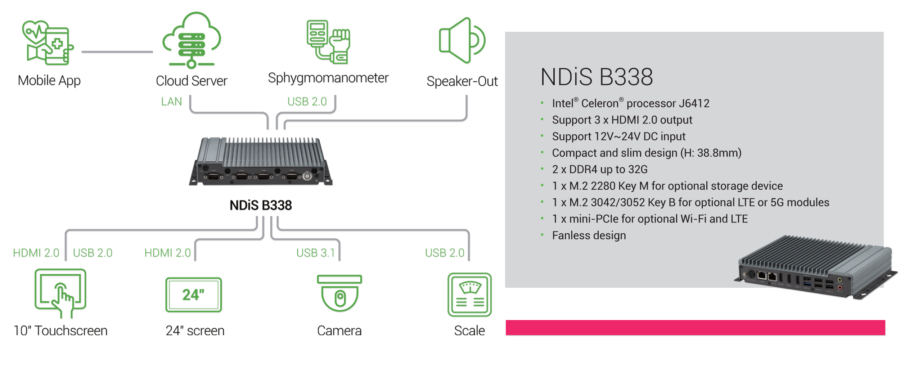
Wide Operating Temperature Support: The NDiS B338 supports a wide operating temperature range from -20°C to 60°C, making it suitable for deployment in various environments, from hot and humid climates to cold and dry conditions. This durability ensures reliable performance regardless of the location.
Power Input Flexibility: The support for 12V~24V DC input provides flexibility in power supply, making the kiosk adaptable to different power sources. This feature is particularly beneficial for remote or underserved areas where power infrastructure may be limited.
Compact and Slim Design: With a compact and slim design (H: 38.8mm), the NDiS B338 can be easily integrated into various kiosk designs. Its sleek profile ensures that the kiosk is unobtrusive and can be placed in high-traffic areas without occupying much space.
Memory and Storage: The NDiS B338 supports up to 32GB of DDR4 memory, ensuring fast and efficient data processing. Additionally, it features an M.2 2280 Key M slot for optional storage devices, providing ample space for storing health data and software applications.
Connectivity Options: The NDiS B338 includes an M.2 3042/3052 Key B slot for optional LTE or 5G modules and a mini-PCIe slot for optional Wi-Fi and LTE. These connectivity options ensure that the kiosk can maintain reliable communication with remote servers and cloud-based health databases, enabling real-time data transfer and updates.
Fanless Design: The fanless design of the NDiS B338 is crucial for maintaining a hygienic environment, reducing noise, and minimising maintenance needs. This design choice ensures that the kiosk remains clean and quiet, enhancing user experience and reducing the risk of component failure.
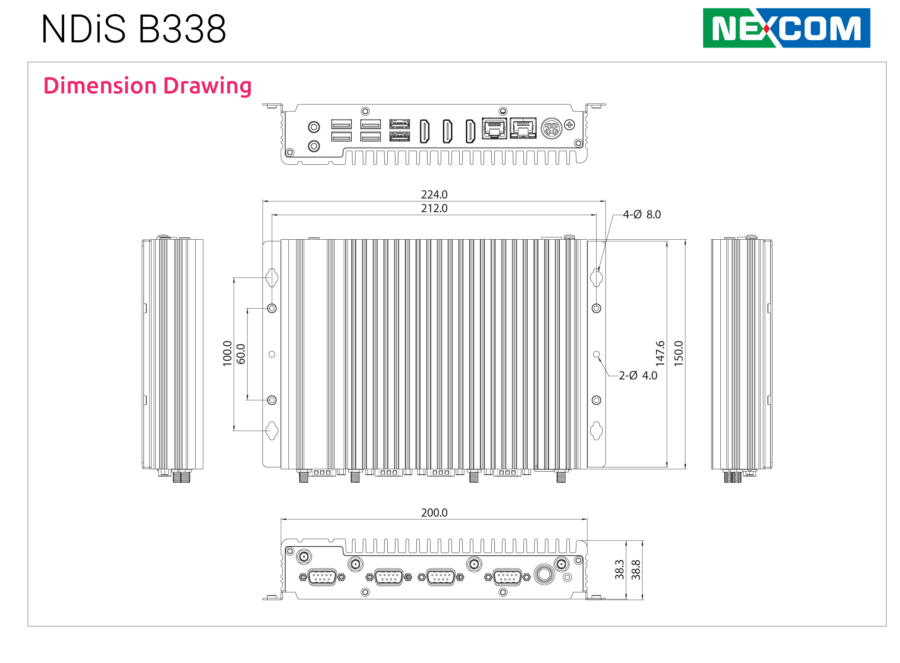
The Impact
Since its introduction, this self-service health check kiosk has seen widespread adoption. Users have praised its ease of use and the immediate insights it provides into their health. The kiosk has empowered individuals to take proactive steps towards their well-being, promoting a culture of preventive healthcare. Additionally, it has significantly reduced the burden on healthcare providers by handling routine health checks, allowing medical professionals to focus on more critical cases.
In summary, the deployment of the NEXCOM NDiS B338 embedded system in self-service health check kiosks offers numerous benefits. These include enhanced user engagement through high-definition visuals, versatile connectivity for various health monitoring devices, and robust performance in diverse environments. The kiosk’s compact, fanless design ensures durability and ease of maintenance, making it an ideal solution for both urban and remote locations. This advanced technology represents a significant step forward in making healthcare more accessible and efficient for all.



